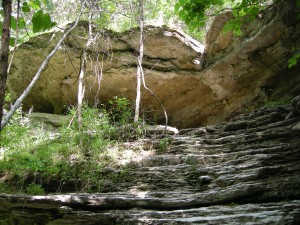Bluff shelters should be preserved not only because they are a warehouse of information for archeologists who seek knowledge about the past. They should also be preserved because they are sacred spaces. Contemporary Native American tribes such as the Osage and Caddo Nations feel a strong historical connection to Ozark bluff shelters, and that they have a responsibility to help protect these sites which may be affiliated with their ancestors. At least two different archeological aspects of these sites speak to their spiritual dimension—use of the shelters as the final resting place for the ancient dead and the presence of rock art which is associated with ritual practices.
Burials of the Ancestors

Many bluff shelter sites across the Arkansas Ozarks contain human burials. For thousands of years Native Americans sometimes buried their dead in bluff shelters and caves in the Ozark Mountains. Researchers Jerry Hilliard and Devon Pettigrew have noted that in the late prehistoric (i.e., Late Woodland and Mississippian), these sites continued to be used as burial places but with notable differences. For instance, large bluffs overlooking the White River came to be specifically used as mortuary houses and the people who were interred here seem to have a special status. Artifacts made of marine shell, imported from the Gulf Coast, were buried with multiple individuals in some bluffs and caves along the White River and its tributaries. These items, because they are rare in the Ozarks, are assumed to belong to people who played an important role within their society. Some burials in the White River bluff shelters are interpreted as litter burials because the 1930s University of Arkansas Museum crew field records noted occurrence of cedar poles underlying burials and woven mats found over and under individuals. The presence of what appear to be litters, marine shell, and multiple individuals interred in “set-aside” repositories at sites like Edens Bluff and Putnam certainly indicate an elaborate burial program during the late prehistoric period in the Ozarks, at least along the Upper White River and in the vicinity of the ceremonial mound centers.
For Native Americans in the Mississippi period, the bluff shelters were already historic sites. Bluff shelters and caves have environmental characteristics that naturally preserve perishable goods and remains for long periods. Native Americans in the prehistoric Ozarks recognized the preservative qualities of these dry bluffs as documented archeologically in the discovery of numerous covered pits with foodstuff and textiles such as cached seed bags. By the time people began building mounds in the Ozarks, generations of their ancestors had used the bluffs leaving behind artifacts that were discovered by these new residents as they cleaned shelter floors, prepared hearths, and dug storage pits. Some of these tools, like ancient dart points and knives, were reused and perhaps even kept as heirloom objects because they were so different. Thus the bluff shelters in the Ozarks may have been historic landmarks even in the prehistoric period. Bluff shelters may have been chosen as specialized burial locations because of a desire to bury relatives at a place where the ancestors once resided and also buried their dead. Bluffs, caves, and shelters, especially those overlooking the major rivers, may have become a place of pilgrimage for the purpose of ritual interment in the prehistoric Ozarks.
In addition to providing a connection to their history, bluff shelters had other attractions as a location for burying the dead. Bluff shelters and caves have unique qualities that Native Americans have long recognized. Geologically they may contain underground features like niches, caves, tunnels, streams, or springs as well as overhangs with grotto-like formations, high passages, niches, and visually interesting patterns on walls and overhangs created by erosion. They provide habitats for various interesting animals, like bats, bears, snakes, salamanders, unusual cave insects, cliff swallows, and many other species. These elements of caves, bluffs, and rock shelters have characteristics easily invested with meaning central to the cosmology and world view of the Native Americans who long occupied the Ozarks, thus making them strong candidates to become sacred places. Many Native American belief systems divide the spirit world into an above world and a below world that have different, sometimes opposite, characteristics. Underground places like caves may have been perceived as symbolically appropriate for burial sites.
Rock Art & Ritual
Not all rock art depicts the supernatural or is a part of ancient rituals. Some rock art depicts naturalistic images from everyday life, like the paddlefish and fish trap pictographs from Rock House Cave. Other examples are more abstract or geometric. However, some rock art seems to be associated with the performance of ritual activities that express the mythological and cosmological beliefs of Native American communities. Some of this ritual rock art is associated with the aforementioned burial sites—such as Edens Bluff, Brown Bluff, Putnam, Peterbottom Cave, and Hulet Cave. Still other examples, especially north of the Arkansas River and in small isolated shelters, have been interpreted as connected to the prehistoric ritual life of Native Americans. Dr. George Sabo’s interpretation of the human figures at The Narrows as a depiction of a dance honoring a Native American creation myth is one such example.
